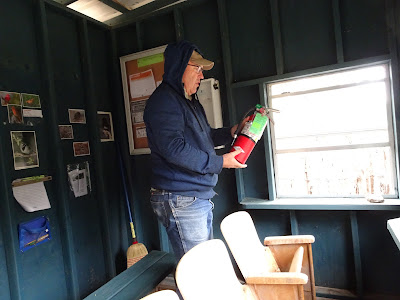We are volunteering at S. Llano River State Park in
Junction, Texas. We’ll be here through
January, 2020. This is a beautiful area
in the Texas Hill Country. We’ve stayed
at this park many times but this is our first time volunteering.
Walter Buck, Jr. moved to this area with his family in
1910 when he was 18 years old. They lived in the house that is now park headquarters. He took over the family ranch after his
father died.
A bachelor all his life, Buck used to say that this land
was his one great love. He donated his whole property to Texas Parks and
Wildlife Department in 1977 for wildlife conservation or park purposes. The
park opened in 1990.
South Llano River State Park expanded from about 600
acres to 2,600 acres in 2011, when the Walter Buck Wildlife Management Area
became part of the state park.
Located on the western edge of the Hill Country, South
Llano River State Park is a unique combination of rocky upland backcountry
and a lush pecan grove river bottom.
One of the largest winter Rio Grande wild turkey roosts
in Central Texas is inside the park.
In the fall and winter, many turkeys gather at the park
and make their way into the pecan forest. In the evening, they fly high up into
the tree branches and sleep there for safety.
Records of turkeys roosting in the park go back about 100
years, but the turkeys have probably been here much longer.
If they are disturbed, they could leave. From October. 1 through March 31, the turkey
roost area is open to the public from 10 a.m. to 3 p.m. This allows plenty of
time in the morning for the turkeys to leave the roost to look for food in the
surrounding area, and time for them to return in the afternoon.
One of our jobs (along with the other 3 volunteer couples) is to open and close the “gates” going into the turkey roosts area.
The park has two miles of river frontage, and multiple
put-in and take-out points for tubers along the way.
S. Llano River
There are 22.7 miles of trails. Trails range from easy to
difficult, and cross river bottoms, steep ridges and wooded areas in between.
There are 58 campsites with water and electric hookups, and
a restroom with showers nearby.
Six walk-in sites have water and a restroom with showers
nearby, while the five primitive hike-in sites have a chemical toilet nearby,
but no water. The five primitive sites
are about 1 1/2 miles from the parking area.
The park has a very active interpretive ranger that
offers lots of activities. The three
months we will be here the park will be closed 2 weeks a month for
hunting. There are only eight hunters
allowed in the park at that time.
Unlike some parks that have a "season" for volunteers (usually Memorial Day to Labor Day), this park has volunteers year-round.
More to come - stay tuned.



















































